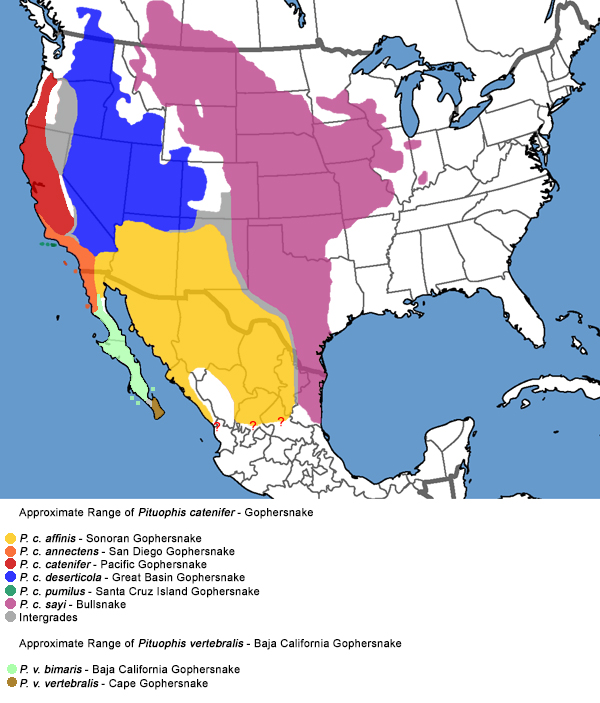Gophersnake - Pituophis catenifer
San Diego Gophersnake - Pituophis catenifer annectens
Baird and Girard, 1853(= San Diego Gopher Snake)
Description • Taxonomy • Species Description • Scientific Name • Alt. Names • Similar Herps • References • Conservation Status
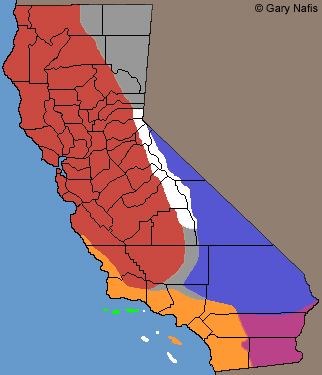
Pituophis catenifer annectens -
San Diego Gophersnake
Range of other subspecies in California:
Purple: Pituophis catenifer affinis - Sonoran Gophersnake
Red: Pituophis catenifer catenifer - Pacific Gophersnake
Dark Blue: Pituophis catenifer deserticola -
Great Basin Gophersnake
Light Green: Pituophis catenifer pumilus -
Santa Cruz Island Gophersnake
Gray: General area of intergradation
Click on the map for a topographical view
Map with California County Names

Listen to a Gophersnake
hissing defensively
 |
|||||||||||||||||||||||||||||||||||||||||||||||||||||||
| Adult, San Diego County mountains | |||||||||||||||||||||||||||||||||||||||||||||||||||||||
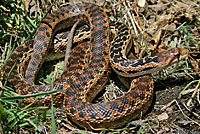 |
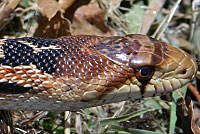 |
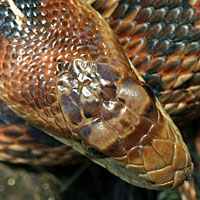 |
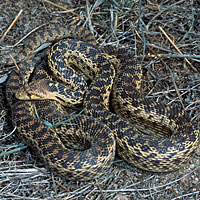 |
||||||||||||||||||||||||||||||||||||||||||||||||||||
| Adult, San Bernardino Mountains, San Bernardino County | Adult, Riverside County | ||||||||||||||||||||||||||||||||||||||||||||||||||||||
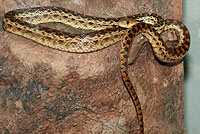 |
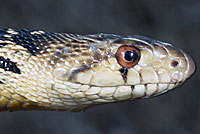 |
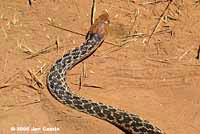 |
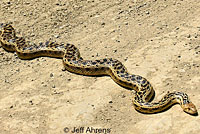 |
||||||||||||||||||||||||||||||||||||||||||||||||||||
| Captive adult, Santa Barbara County | Adult, Riverside County | Adult, Santa Barbara County © Jen Castle |
Adult, Riverside County © Jeff Ahrens |
||||||||||||||||||||||||||||||||||||||||||||||||||||
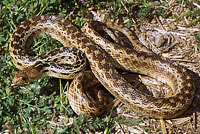 |
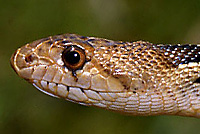 |
 |
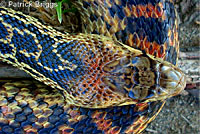 |
||||||||||||||||||||||||||||||||||||||||||||||||||||
| Adult, Riverside County | Adult, San Luis Obispo County © Patrick Briggs | ||||||||||||||||||||||||||||||||||||||||||||||||||||||
 |
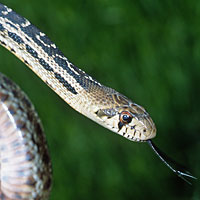 |
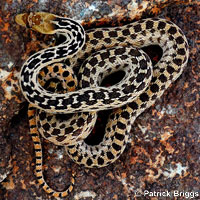 |
 |
||||||||||||||||||||||||||||||||||||||||||||||||||||
| Adult, Orange County © Tadd Kraft | Adult, Riverside County | Adult, San Bernardino County © Patrick Briggs | |||||||||||||||||||||||||||||||||||||||||||||||||||||
 |
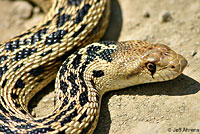 |
 |
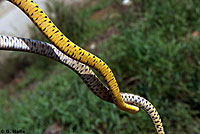 |
||||||||||||||||||||||||||||||||||||||||||||||||||||
| Adult, Orange County © Ivan Vershynin | Adult, Riverside County © Jeff Ahrens |
Adult, San Diego County coast, © Patrick Briggs |
Underside of adult, San Diego County | ||||||||||||||||||||||||||||||||||||||||||||||||||||
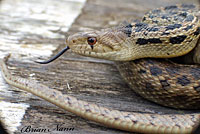 |
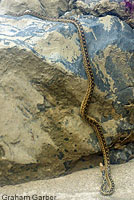 |
 |
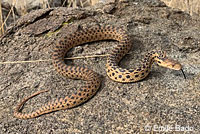 |
||||||||||||||||||||||||||||||||||||||||||||||||||||
| Adult, Orange County © Brian Nann | This adult is shown as it was found, climbing a rock next to a damp stream bed on an April morning in a Riverside County canyon. © Graham Garber |
This San Diego Gophersnake was observed crawling up the stucco wall next to the front door on the outside of a house in Riverside County. © Gary Sopata |
Adult, Riverside County © Emile Bado |
||||||||||||||||||||||||||||||||||||||||||||||||||||
 |
 |
 |
|||||||||||||||||||||||||||||||||||||||||||||||||||||
| This snake was found at a home in the mountains of Santa Catalina Island. | This San Diego County adult is displaying a typical gophersnake defensive posture with the head flattened into a triangular shape and the body semi-coiled, which resemble a defensive rattlesnake. Typically a gophersnake will also hiss loudly and shake its tail to make a rattling sound in dry leaves. © Michael Van Zandt | ||||||||||||||||||||||||||||||||||||||||||||||||||||||
 |
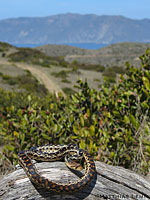 |
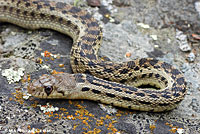 |
 |
||||||||||||||||||||||||||||||||||||||||||||||||||||
| Adult, Los Angeles County desert, © Zeev Nitzan Ginsburg |
Adult, Santa Catalina Island, Los Angeles County © Matthias Lemm | Adult, Santa Catalina Island, Los Angeles County © Matthias Lemm | Adult, Santa Catalina Island, Los Angeles County © Matthias Lemm | ||||||||||||||||||||||||||||||||||||||||||||||||||||
| Juveniles | |||||||||||||||||||||||||||||||||||||||||||||||||||||||
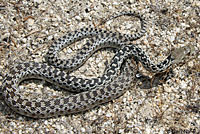 |
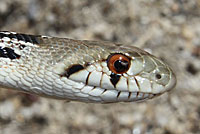 |
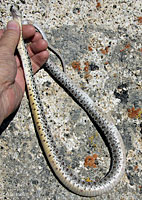 |
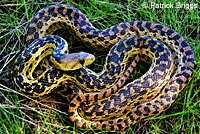 |
||||||||||||||||||||||||||||||||||||||||||||||||||||
| Juvenile, San Diego County | Juvenile, San Diego County, © Patrick Briggs |
||||||||||||||||||||||||||||||||||||||||||||||||||||||
 |
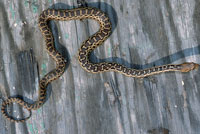 |
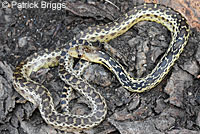 |
|||||||||||||||||||||||||||||||||||||||||||||||||||||
| Sub-adult, San Diego County | Sub-adult, Riverside County | Subadult, San Diego County, © Patrick Briggs |
|||||||||||||||||||||||||||||||||||||||||||||||||||||
Interesting or Unusual San Diego Gophersnakes |
|||||||||||||||||||||||||||||||||||||||||||||||||||||||
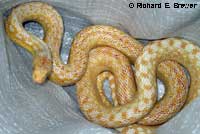 |
 |
 |
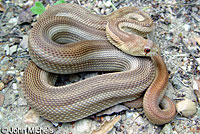 |
||||||||||||||||||||||||||||||||||||||||||||||||||||
| Albino adult, San Diego County. © Richard E. Brewer | Patternless adult, Los Angeles County © 2006 John Michels |
||||||||||||||||||||||||||||||||||||||||||||||||||||||
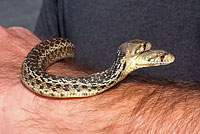 |
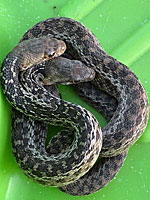 |
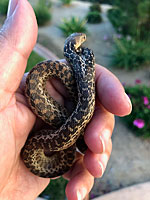 |
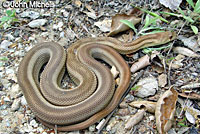 |
||||||||||||||||||||||||||||||||||||||||||||||||||||
| This juvenile gophersnake with two heads was found near the Santa Ana mountains in Riverside County. Two-headed snakes are rare, but they show up occasionally in the wild and with captive breeding. |
Patternless adult, Los Angeles County © 2006 John Michels |
||||||||||||||||||||||||||||||||||||||||||||||||||||||
 |
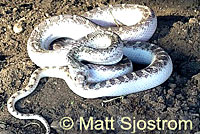 |
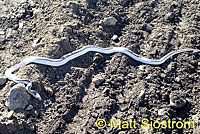 |
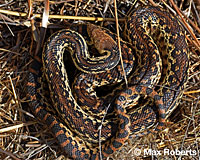 |
||||||||||||||||||||||||||||||||||||||||||||||||||||
| White-sided adult, San Bernardino County © Matt Sjostrom | Adult with an orange stripe and yellow dots on its back from the Santa Monica Mountains, Ventura County. © Max Roberts |
||||||||||||||||||||||||||||||||||||||||||||||||||||||
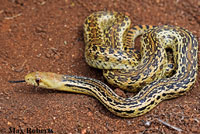 |
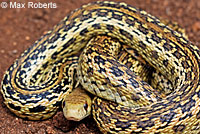 |
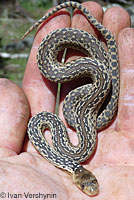 |
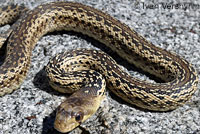 |
||||||||||||||||||||||||||||||||||||||||||||||||||||
| This San Diego Gophersnake with a dorsal stripe on much of its body was found a half a mile or more from the similar snake to the left in Ventura County. © Max Roberts |
This snake from San Diego County has a partial dorsal stripe © Ivan Vershynin | ||||||||||||||||||||||||||||||||||||||||||||||||||||||
 |
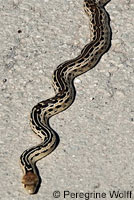 |
 |
|||||||||||||||||||||||||||||||||||||||||||||||||||||
| This partially-striped adult San Diego Gophersnake was photographed in Ventura County. © Peregrine Wolff. Most striped gophersnakes seem to be Pacific Gophersnakes found in Solano and Napa Counties. |
This adult snake from Monterey County has an unusual pattern, or lack of one, on the upper part of its body. © Ryan Sikola |
||||||||||||||||||||||||||||||||||||||||||||||||||||||
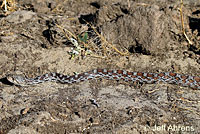 |
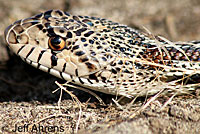 |
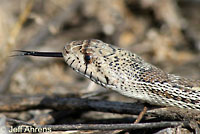 |
 |
||||||||||||||||||||||||||||||||||||||||||||||||||||
| Adult from near Chino, San Bernardino County © Jeff Ahrens | Adult from near Chino, San Bernardino County © Jeff Ahrens | ||||||||||||||||||||||||||||||||||||||||||||||||||||||
| Both of the snakes above show some similiarities in appearance to the subspecies P. c. affinis, but they were found at least 50 miles from the range of that subspecies. They were also found within close proximity at the same time which tends to rule out the likelihood they were both transported and released to the area. |
|||||||||||||||||||||||||||||||||||||||||||||||||||||||
 |
 |
||||||||||||||||||||||||||||||||||||||||||||||||||||||
| This Riverside County adult has an unusual amount of yellow. © B. Kraus | |||||||||||||||||||||||||||||||||||||||||||||||||||||||
| Snakes From Intergrade Areas | |||||||||||||||||||||||||||||||||||||||||||||||||||||||
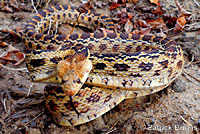 |
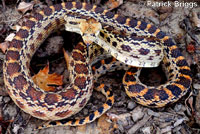 |
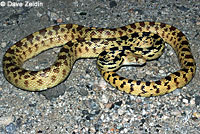 |
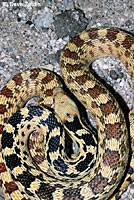 |
||||||||||||||||||||||||||||||||||||||||||||||||||||
| Adult from Los Angeles County intergrade area where P. c. annectens intergrades with P. c. deserticola. © Patrick Briggs | This adult snake from the desert in Riverside County near San Gorgonio pass where the two subspecies meet shows a dark pattern towards the head characteristic of P. c. annectens and a yellow-orange coloration at the tail end characteristic of P. c. affinis. © Dave Zeldin | ||||||||||||||||||||||||||||||||||||||||||||||||||||||
 |
|||||||||||||||||||||||||||||||||||||||||||||||||||||||
| This pink-sided adult is from the area in Los Angeles County where San Diego and Great Basin Gophersnakes interbreed. © Zeev Nitzan Ginsburg | |||||||||||||||||||||||||||||||||||||||||||||||||||||||
| Gophersnakes Feeding | |||||||||||||||||||||||||||||||||||||||||||||||||||||||
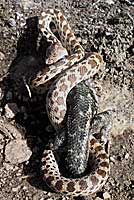 |
 |
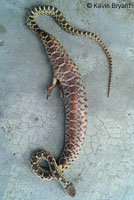 |
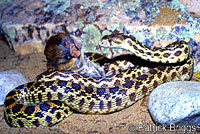 |
||||||||||||||||||||||||||||||||||||||||||||||||||||
| Juvenile Pacific Gophersnake, Mariposa County, eating a Western Fence Lizard © Daniel Harris |
This dead juvenile Pacific Gophersnake was found in Sutter County. It appears to have a leg, but on closer inspection, it is the leg of what is probably an alligator lizard that broke through the snake's side after the snake swallowed it. © Kevin Bryant |
Adult Pacific Gophersnake, Kings County, preparing to eat its namesake mammal - a gopher. © Patrick Briggs | |||||||||||||||||||||||||||||||||||||||||||||||||||||
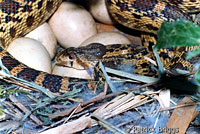 |
 |
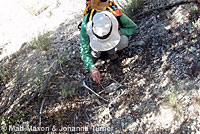 |
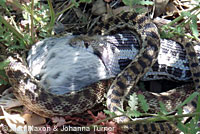 |
||||||||||||||||||||||||||||||||||||||||||||||||||||
| Adult Pacific Gophersnake in a bird's nest eating a duck egg, Kings County, © Patrick Briggs |
A juvenile Pacific Gophersnake eating a Coast Range Fence Lizard in Sonoma County © Gérard Menut | Matt Maxon and Johanna Turner were hiking in Big Tujunga Canyon in Los Angeles County when they discovered a large dead rodent that appeared to have been partially swallowed and spit out. (Left) On returning to the same spot about two hours later, they noticed the rodent was gone, and soon discovered a San Diego Gophersnake swallowing it. (Right) Did the snake kill the rodent, attempt to eat it, then spit it out and return later to try again, or was more than one predator involved? We'll never know, but that sure is more than a mouthful. © Matt Maxon and Johanna Turner. |
|||||||||||||||||||||||||||||||||||||||||||||||||||||
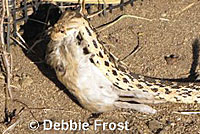 |
 |
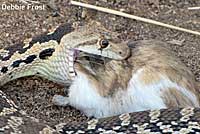 |
|||||||||||||||||||||||||||||||||||||||||||||||||||||
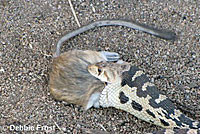 |
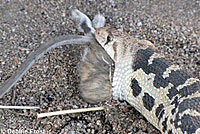 |
||||||||||||||||||||||||||||||||||||||||||||||||||||||
| Debbie Frost saw a Great Basin Gophersnake that had just bred in Lassen County crawl down a hole, and quickly coming back up with a kangaroo rat. The snake then crawled into the shade made by Debbie's shadow and ate while she watched. | |||||||||||||||||||||||||||||||||||||||||||||||||||||||
| Gophersnake Predation | |||||||||||||||||||||||||||||||||||||||||||||||||||||||
 |
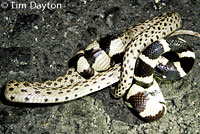 |
 |
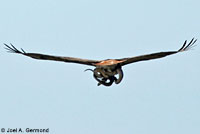 |
||||||||||||||||||||||||||||||||||||||||||||||||||||
| A California Kingsnake killing a Pacific Gophersnake for dinner in Contra Costa County. © Tim Dayton |
Gophersnakes are sometimes preyed upon by birds of prey, or raptors. Here, a San Diego Gophersnake is carried off by a Red-tailed Hawk in coastal San Luis Obispo County. © Joel A. Germond | ||||||||||||||||||||||||||||||||||||||||||||||||||||||
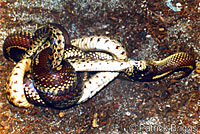 |
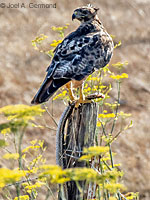 |
||||||||||||||||||||||||||||||||||||||||||||||||||||||
| California Kingsnakes are powerful predators capable of eating other snakes almost as large as they are. Here you can see one eating a Pacific Gophersnake. © Patrick Brigg |
A juvenile Red-tailed Hawk with a freshly-killed San Diego Gophersnake in coastal San Luis Obispo County. © Joel A. Germond |
||||||||||||||||||||||||||||||||||||||||||||||||||||||
| Breeding | |||||||||||||||||||||||||||||||||||||||||||||||||||||||
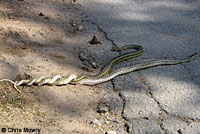 |
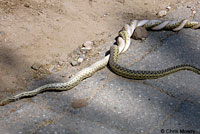 |
 |
|||||||||||||||||||||||||||||||||||||||||||||||||||||
| Two adults all twisted up in Los Angeles County - they were described to me as a mating pair, but the are most likely two males fighting over access to a nearby female. © Chris Mowry |
|||||||||||||||||||||||||||||||||||||||||||||||||||||||
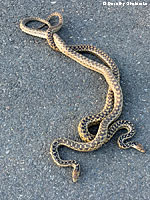 |
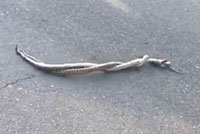 |
||||||||||||||||||||||||||||||||||||||||||||||||||||||
| San Diego Gophersnakes wrestling on a Riverside County rural road in May during the breeding season. © Dorothy Sheldrake. Click the image on the right to watch a short video. | |||||||||||||||||||||||||||||||||||||||||||||||||||||||
| Gophersnake Tracks | |||||||||||||||||||||||||||||||||||||||||||||||||||||||
 |
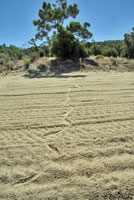 |
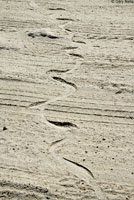 |
|||||||||||||||||||||||||||||||||||||||||||||||||||||
| Young adult, San Diego County. Its tracks on a sandy road show how it slipped from side to side to get traction in the sand. | |||||||||||||||||||||||||||||||||||||||||||||||||||||||
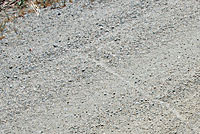 |
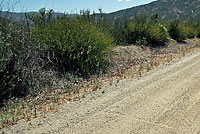 |
||||||||||||||||||||||||||||||||||||||||||||||||||||||
| Tracks of a large adult across a harder surface are almost in a straight line, San Diego County |
|||||||||||||||||||||||||||||||||||||||||||||||||||||||
| The Danger of Plastic Netting to Snakes | |||||||||||||||||||||||||||||||||||||||||||||||||||||||
 |
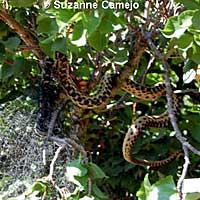 |
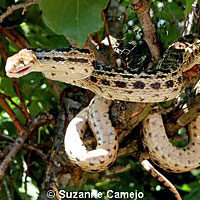 |
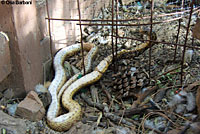 |
||||||||||||||||||||||||||||||||||||||||||||||||||||
| Suzanne Camejo found this San Diego Gophersnake in an apricot tree which it had climbed probably trying to raid a Mockingbird nest. The snake was entangled in synthetic netting used to protect the fruit from birds. Suzanne and her friends cut the netting, which had dug into the snake's skin, to free the snake. They were repaid with the hissing and striking of a very stressed-out snake, but one that was now free to crawl away and continue to rid the garden of rodents and rabbits. Although netting is used as a natural method to deter agricultural pests, as well as for erosion control, it can be a great hazard to some animals, especially snakes. Photos © Suzanne Camejo |
This San Diego Gophersnake was found entangled in synthetic "wildlife netting" used as a barrier to rodents and other pests. After freeing two snakes that were found entangled in the netting, the property owner removed the netting to protect the snakes. © Osa Barbani |
||||||||||||||||||||||||||||||||||||||||||||||||||||||
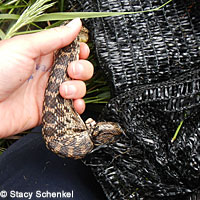 |
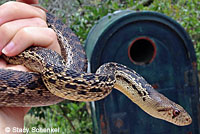 |
||||||||||||||||||||||||||||||||||||||||||||||||||||||
| This San Diego Gophersnake found in Orange County, was rescued after it was trapped in a tarp with small mesh that was used to cover backyard stuff. Snakes will try to crawl through any open mesh, not just that used in plastic netting. © Stacy Schenkel |
|||||||||||||||||||||||||||||||||||||||||||||||||||||||
| How to Tell the Difference Between Gophersnakes and Rattlesnakes | |||||||||||||||||||||||||||||||||||||||||||||||||||||||
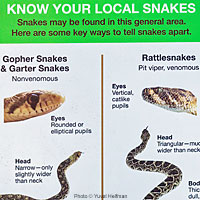 |
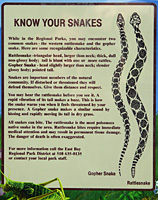 |
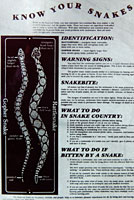 |
|||||||||||||||||||||||||||||||||||||||||||||||||||||
| © Yuval Helfman | |||||||||||||||||||||||||||||||||||||||||||||||||||||||
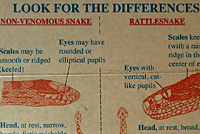 |
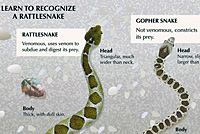 |
||||||||||||||||||||||||||||||||||||||||||||||||||||||
|
Harmless and beneficial gophersnakes are sometimes mistaken for dangerous rattlesnakes. Gophersnakes are often killed unnecessarily because of this confusion. (It's also not necessary to kill every rattlesnake.) It is easy to avoid this mistake by learning to tell the difference between the two families of snakes. The informational signs shown above can help to educate you about these differences. (Click to enlarge). If you can't see enough detail on a snake to be sure it is not a rattlesnake or if you have any doubt that it is harmless, leave it alone. You should never handle a snake unless you are absolutely sure that it is not dangerous. |
|||||||||||||||||||||||||||||||||||||||||||||||||||||||
| Habitat | |||||||||||||||||||||||||||||||||||||||||||||||||||||||
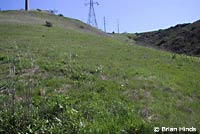 |
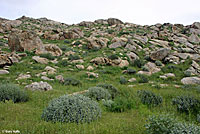 |
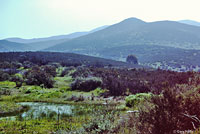 |
 |
||||||||||||||||||||||||||||||||||||||||||||||||||||
| Coastal San Diego County grassland habitat that is rapidly disappearing due to development. © Brian Hinds | Habitat, Riverside County | Habitat, small creek, San Diego County |
Habitat, San Diego County |
||||||||||||||||||||||||||||||||||||||||||||||||||||
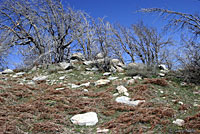 |
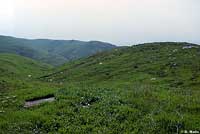 |
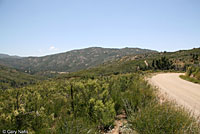 |
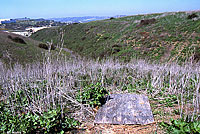 |
||||||||||||||||||||||||||||||||||||||||||||||||||||
| Habitat,6,200 ft. San Bernardino County |
Habitat, Riverside County | Habitat, 3,000 ft., San Diego County | Habitat, coastal San Diego County grassland | ||||||||||||||||||||||||||||||||||||||||||||||||||||
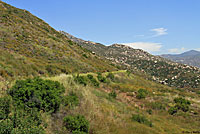 |
 |
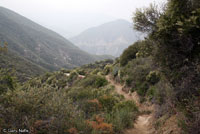 |
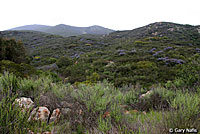 |
||||||||||||||||||||||||||||||||||||||||||||||||||||
| Coastal scrub habitat, San Diego County |
Habitat, hill next to suburbs, San Diego County |
Habitat, San Gabriel Mountains, Los Angeles County | Habitat, San Diego County coastal scrub | ||||||||||||||||||||||||||||||||||||||||||||||||||||
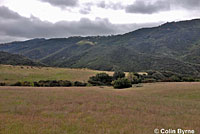 |
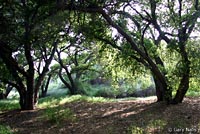 |
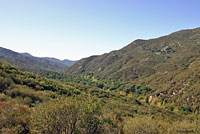 |
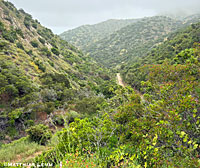 |
||||||||||||||||||||||||||||||||||||||||||||||||||||
| Habitat, Santa Monica Mountains, Los Angeles County © Colin Byrne | Habitat, riparian canyon, Los Angeles County |
Habitat, Santa Ana Mountains, Riverside County |
Santa Catalina Island © Matthias Lemm | ||||||||||||||||||||||||||||||||||||||||||||||||||||
| Short Videos | |||||||||||||||||||||||||||||||||||||||||||||||||||||||
 |
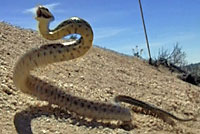 |
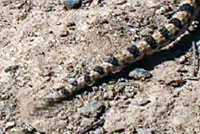 |
|||||||||||||||||||||||||||||||||||||||||||||||||||||
| A San Diego Gophersnake flicks its tongue and crawls across a dirt road. | A San Diego Gopher snake is discovered on a dirt road in the morning. It becomes defensive when I follow it, hissing and striking out to warn me to back off. | A distressed Pacific Gophersnake shakes its tail rapidly, which makes a buzzing sound as the tail touches the ground. This behavior might be a mimic of a rattlesnake's rattling, or it could be a similar behavior that helps to warn off an animal that could be a threat to the gopher snake. | |||||||||||||||||||||||||||||||||||||||||||||||||||||
|
|||||||||||||||||||||||||||||||||||||||||||||||||||||||
|
|||||||||||||||||||||||||||||||||||||||||||||||||||||||
|
The following conservation status listings for this animal are taken from the July 2025 State of California Special Animals List and the July 2025 Federally Listed Endangered and Threatened Animals of California list (unless indicated otherwise below.) Both lists are produced by multiple agencies every year, and sometimes more than once per year, so the conservation status listing information found below might not be from the most recent lists, but they don't change a great deal from year to year.. To make sure you are seeing the most recent listings, go to this California Department of Fish and Wildlife web page where you can search for and download both lists: https://www.wildlife.ca.gov/Data/CNDDB/Plants-and-Animals. A detailed explanation of the meaning of the status listing symbols can be found at the beginning of the two lists. For quick reference, I have included them on my Special Status Information page. If no status is listed here, the animal is not included on either list. This most likely indicates that there are no serious conservation concerns for the animal. To find out more about an animal's status you can also go to the NatureServe and IUCN websites to check their rankings. Check the current California Department of Fish and Wildlife sport fishing regulations to find out if this animal can be legally pursued and handled or collected with possession of a current fishing license. You can also look at the summary of the sport fishing regulations as they apply only to reptiles and amphibians that has been made for this website. This snake is not included on the Special Animals List, which indicates that there are no significant conservation concerns for it in California. |
||
| Organization | Status Listing | Notes |
| NatureServe Global Ranking | ||
| NatureServe State Ranking | ||
| U.S. Endangered Species Act (ESA) | None | |
| California Endangered Species Act (CESA) | None | |
| California Department of Fish and Wildlife | None | |
| Bureau of Land Management | None | |
| USDA Forest Service | None | |
| IUCN | ||
Return to the Top
© 2000 -


